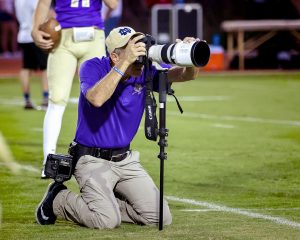- Slug: Sports-Local Sports Photographer, about 900 words.
- Photos available
By Erica Block
Cronkite News
PHOENIX – If you’ve ever been to a high school football game at Notre Dame Prep in Scottsdale, you’ve probably seen Mike Harvey on the sidelines, kneeling behind a giant telescopic camera lens. Over the past seven years Harvey has carved out a niche for himself photographing the Saints at sporting events throughout Maricopa County.
Many of the pictures adorning the Notre Dame Prep athletics website and social media channels are photos that he shot.
But the prep school in Scottsdale isn’t the only Notre Dame Harvey has assisted. Thirty-five years ago he was the right-hand man of Fighting Irish coach Gerry Faust, a job that saw Harvey dabbling in sports analytics and that landed him on the cover of Sports Illustrated. This isn’t his first experience working on the sidelines.
As a student at the University of Notre Dame, Harvey served as a student manager for the Fighting Irish football team during the 1984 season. While working under Coach Faust that season, Harvey and Dick Larkin, a fellow student manager, were assigned the job of processing team stats. On Sunday nights, Harvey and Larkin would spend several hours copying the team data onto punch cards before running the cards through a rudimentary program at the campus computer center.
“If there was a single typo, the job would fail and we would receive the tray of cards back with one of them sticking out to be corrected,” Larkin said. “The consoles didn’t have a display, so you couldn’t tell if you were making a mistake.”
After Harvey and Larkin processed the punch cards, Larkin explained, the computer would generate a thick report.
The two of them would then deliver the report to the Notre Dame football office. While Larkin found the job tedious, Harvey began printing extra copies of the report for himself.
He became absorbed in the volume of information he had collected and began noticing patterns among the football plays contained in the report.
“This was way before coaches started using analytics to inform game strategy,” Larkin pointed out. “But Mike was totally into understanding the tendencies of our opponents.”
Although applying quantitative methods to analyze scouting reports and past player performance is fairly common today, this was 1984, the year the first Apple computer made its debut, and years before sports teams would begin using analytics to inform game strategy. Using data analytics wouldn’t become a mainstream practice in college and professional sports for nearly 20 years. Moneyball, Michael Lewis’ book that put sabermetrics on the radar of baseball fans and front offices, was published in 2003, and NFL teams only began using analytics in earnest to gain a competitive advantage several years ago.
Coach Faust seemed to recognize that Harvey was onto something, Larkin recalls.
“I remember standing next to him on the sideline of a game and it was late in the third quarter,” Larkin said. “The opponent had the ball, and it was something like third down with 9 yards to go. Mike said, ‘They’re going to fake a run and throw a screen to the left side. They do it every time they’re in this situation’.”
The Fighting Irish football team employs more than 20 student managers in a typical year. Harvey’s dedication and unique approach to the job made him stand out among his peers. After taking notice of the strategic knowledge his Head Football Manager had to offer, Coach Faust hired Harvey, then a senior engineering major, as his personal coaching assistant. Harvey can be seen by the coach’s side in scores of photographs documenting Notre Dame’s 1984 football season.
Part of the job involved driving a tall scissor lift around the Fighting Irish practice fields. Harvey was responsible for setting up the giant lift in the correct location, based on the practice period and what particular drills or plays were taking place at different locations on the field.
In other words, he had to track multiple events unfolding at the same time, while anticipating where to focus and position himself next. This way of thinking and ability to multitask is also necessary in Harvey’s current role as a sports action photographer.
“The variety of plays and action that occur in a football game are fun to capture,” Harvey said. “The drama and spontaneity of players’ reactions make for really good pictures.”
Varsity football games at Notre Dame Prep tend to boast larger crowds than other high school sports. Harvey likes the electric feel of being in a big stadium environment and enjoys feeding off the crowd’s frenetic energy.
It’s no surprise that football is Harvey’s favorite sport to shoot, considering his experience on the sidelines in college.
In his role behind the camera, Harvey can share in the joy and excitement that athletes feel when they are competing. He offers his experience on the sidelines of Notre Dame’s state championship football game against Centennial High a few years ago as an example.
“I didn’t participate in that game and here I am, five years later, recalling the feeling of those moments,” he said. “I kind of live in the moment with the players.”
Harvey loves sports, but has always wanted to be involved in a support capacity. He feels fortunate that he was able to turn his passion into a profession, and still aspires to connect his current role on the sidelines with the one he enjoyed while in college.
“One of my dreams is to photograph a college football game and more specifically, a Notre Dame college football game,” he said. “That would be the ultimate thrill.”
For more stories from Cronkite News, visit cronkitenews.azpbs.org.

